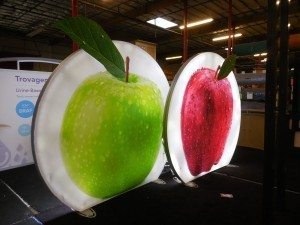Creativity For Trade Show Managers: Part Two
In our blog last week, we talked about how creativity can be useful for a trade show manager. A creative approach will help you develop fresh and exciting ways of telling show visitors about your product or service.
We talked about how creativity isn’t a synonym for cleverness. Sometimes, clever ideas can work. Other times, they’re just corny or silly. But they’re not helpful for promoting your company, your product or your brand.
Creativity is synonymous with originality and innovation. And that can add value to promoting whatever you sell on the show floor.
I also mentioned that applied creativity, used to develop a unique theme or concept for your trade show promotions, usually follows a three-step plan:
- Identify the need,
- Brainstorm a great idea,
- Package and sell the idea to stakeholders.
The previous blog entry (Creativity-Part 1) covered the first two steps of this plan.
- Identifying the need
In dealing with the first step, I claimed that creativity should have a reason to exist. When you’ve been doing the same thing over and over again, or even the same kind of thing, you’re due for a change. That’s when creativity is necessary.
- Brainstorming
The second step sounds difficult and challenging, but it’s not if you assemble the right team. I suggested that a successful brainstorming team will include Creative Thinkers, Improvisers, Detail People and Convincers.
They all have important parts to play, but in this article, we’re focusing on the Convincers. These are the people who will be most important when it comes to getting buy-in from management for your creative concept.
Convincers are skilled at preparing a case for the creative approach you’re proposing, just like a lawyer prepares before speaking to a jury. They think through all possible objections and come up with valid counter-arguments.
Just remember, you’re probably going to be presenting your concept to upper management and an accountant or two (or more). These are among the least imaginative people in your company.
Your Convincers have to understand what your new concept will bring in terms of ROI. That way, they can speak in language that accountants and management appreciate.
Here’s how they can help you get approval for the great idea you and your team have developed:

SuperNova Lightboxes with Creative SEG Tension Fabric Graphic Design (Are these printed or attached?!)
- Packaging and Selling Your Idea
Your creative team did its job. You’ve got an idea that will blow them away. Now is the time for the “Convincers” to do their part. Their “case” should include:
- Your purpose: This isn’t change for the sake of change. There’s a reason for it. Make this clearly understood. Bring in supporting research if you have it.
Then lay out what you’ve been doing, why it’s not working as well as it once did (or like you hoped it would), and what you plan to do to fix it.
- Your idea, spelled out: Use any tools you can to explain the creative approach for your marketing program, like artwork, photos, props, models and reference materials.
You need to transfer the image of what you see in your mind, in all its detail, to these people. You’re giving them the “who,” “what,” “when,” “where” and “how” this is all supposed to work.
- Features and benefits of your idea: Summarize the main features that will be most noticeable and memorable. Present the advantages of your creative approach and always remember to include the benefit(s) to the booth visitor.
- Proposed expectations: This presentation should include a forecast of expected leads, traffic flow and results. Use quantifiable calculations (this makes the accountants very happy).
Along with presenting the numbers, go ahead and let your passion for the project show. That’s what they’ll be responding to.
- Budget recommendations: Provide a list showing how much your plan will cost, what needs to be done, how much will be handled in-house, and what will be outsourced to other vendors.
- ROI: This is pivotally important. What you’re presenting here is exactly what your team believes the company will get as the result of taking this approach at your next show.
Don’t choke on this point. Even if you’ve aced all the other parts, if you don’t deliver a winning argument here, you won’t bring them over to your side.
One tip: Know your audience. Before you present to decision makers, investigate how they think.
Are there good and bad times for enlisting the boss’s support?
What approach do they like personally, and why?
And don’t forget to show them what’s in it for them, if they approve your plan.
That’s how I’d do it if I were in your shoes. In fact, that is what we do here at American Image Designs when we’re asked to come up with creative approaches for our clients.
Just remember: doing nothing is as risky as trying something new. As Henry Ford once said, “You can’t build a reputation on what you’re going to do.”
We take a great deal of pleasure in helping our clients create something new and innovative.
Remember that we work with clients in many different industries. Because of this, we may have ideas that have worked in fields other than your own, that you could “borrow” for what you’re planning. Just ask us. Call (888) 977-8076 or email [email protected].
For more, read our part 1 on creativity for trade show managers or how to be a better trade show manager.

